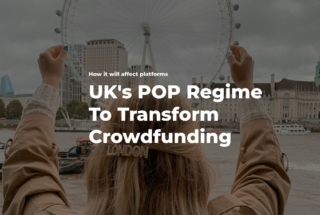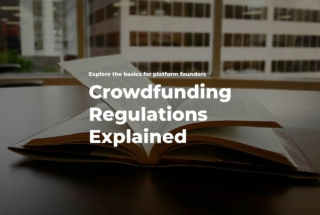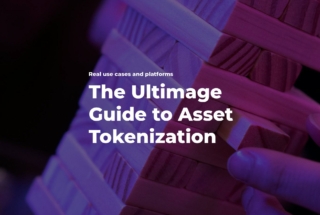How a P2P Lending Platform for Real Estate Actually Works: BA Exclusives Part 2
No time to read? Let AI give you a quick summary of this article.
In Part 1 called P2P Lending for Real Estate – Business Model, we talked about how the niche was born, why it became popular and who is the target audience. This is Part 2 of the series where we talk about the technical side of a P2P lending platform and how it works.
Apart from that, we focus more on each user role such as investor, developer, platform owner, and advisor and how they all collaborate on a P2P lending platform.
Without further ado, let’s just jump straight into it.
What you will learn in this post:
How loan evaluation works on a P2P lending platform for real estate
The right choice of property developers and professional due diligence are the pillars of the success of the real estate crowdfunding platform. Due diligence is a long and daunting process with a lot of manual work. There are plenty of AI services for the assessment of risks and solvency but they are hardly ever used in practice due to their relative effectiveness and accuracy required for a particular business. Each project is unique in some way, so platform owners usually hire loan evaluation experts to conduct the due diligence of a property developer application.
Serious crowdfunding platforms usually reject 98% of the applications and thoroughly select projects. Investing in real estate is a serious venture and any failures, defaults of developers immediately affect the platform’s credibility, trustworthiness and reputation.
Sometimes, crowdfunding platforms create an additional, property developer’s, role on the platform to partially automate the process of the deal evaluation.
After the high-level pre-evaluation of the application (usually, a few emails or a call), the loan evaluation expert rejects or accepts the application for further due diligence. Later, a loan evaluation expert creates an in-depth questionnaire for the developer through the admin panel and sends an invitation to complete the survey and upload the required documents. Simplifying further work because all information is stored in one place, the loan evaluation expert can share the information with the whole team.
When the developer has filled the whole due diligence form and attached the documents, the loan evaluation expert checks the information and makes a final decision on whether to accept or reject the request for crowdfunding. The functionality for the developer role is limited. And if the developer is professional and lucky (among the accepted 2%) the rest of the project including marketing and fundraising is carried by the Admin of the platform directly.
KYC/AML and whether you need it on your debt crowdfunding platform
KYC/AML is pretty straightforward. The goal is to protect the users from fraud and illegal operations. This is the requirement of the ethical and legislative policies.
To ensure the safety of operations, the Admin of the platform has to make sure that a user is not pretending to be someone else, is not sanctioned or found in any blacklists. Today, KYC/AML verification has been fully automated with the right for the admin to make a final decision on whether to accept or reject the user from using the platform or making a transaction. The manual KYC/AML is usually performed only when the online verification failed or was found disputable (e.g., a service provider can’t verify the user correctly – for example, a foreigner.)
Usually, platforms have an online payment gateway which also must conduct the KYC/AML verification, so a special service focusing on KYC/AML only without payment processing is often unnecessary. However, all-in-one payment gateways tend to be slower and may take up to 24 hours to complete the KYC/AML check.
For institutional investors, it’s not enough to verify the user that is registering on the platform. It’s vital to conduct the verification of a company on behalf of which the investments will be performed. Apart from that, an agreement from all of the shareholders and ultimate beneficial owners (UBOs) is required. They have to know and agree to invest the company’s money on the crowdfunding platform. Further communication, proof of consent of the institutional investors is conducted by the Admin manually.
There aren’t that many institutional investors on the platform, usually 1-2 in 100 users, so there is no need in automation for this part. However, after the case with the London Capital and Finance (LFC)1, I believe there will be more institutional investors and the demand for automation will grow.
P2P lending platform investment settlement and money flow
The sweet part. Setting investments and pooling funds.
When all of the docs are signed (usually an offline process by the way), the offering is being set up. The marketing manager or campaign admin writes descriptions, outlines the terms, creates promotional materials like image galleries, videos, etc.
Rarely does a project make it to the offering on a crowdfunding platform, but when it happens, the platform does its best job to ensure the success of the project.
There are two types of crowdfunding:
- Traditional
- Pre-funding
The traditional approach is when the platform opens a crowdfunding campaign for a set period of time. Often used in a “Keep-It-All” model, the fundraiser can get whatever it was possible to gather within a few days, weeks or months. This approach is risky.
The problem with it is that the developer doesn’t get the money quickly. The company has to wait until the funding is complete, and there is a chance it might not gather the required sum of money within a few days or during the whole campaign.
In addition to that, a rare developer wants its money to sit on the platform without profiting the company. That’s why some platforms offer to partially cover the funding amount before launching a public crowdfunding campaign. Thus investors are basically backing up the platform pre-funding “expenses” and not the actual offering.
But how does that platform profit?
Well, here is how it works. The platform provides a loan for the developer under 15% annual interest rate while investors are investing under the 8% – protfit. Thus, the campaign closing period is very relative. De facto, the developer already received its money, while investments are processed and settled within several hours or days.
For the user on the platform, nothing is visually changing. The only difference is to which bank account the money goes.
Such an approach isn’t a bad thing. In fact, it allows everyday investors to invest in high-value deals when the platform has actually already invested in the offering. It’s good to know that the professionals have taken the calculated step while an investor can enjoy the returns relatively safely if the whole thing works out. Apart from that, this approach is also less stressful for the crowdfunding platform itself. The platform can focus more on negotiations and proper campaign management.
Investment settlement – an investment counts an investment and starts making profits when the money is transferred to the developer. In the real estate crowdfunding industry, investment settlement is a broadly used term. However, in traditional crowdfunding settlement happens on the completion of the funding campaign after the money is transferred to the developer and the repayment schedule is generated for the investor.
The steps to investment settlement may differ depending on whether payment gateway is integrated on the platform. Thus, without an integrated payment system, investors send money directly to the bank account of the platform (or to platform solicitors). The money is held there until the end of the campaign and then manually sent to the developer’s account. All of the status investment and payment status changes are purely for representational purposes and are controlled manually from the admin back office.
When the payment gateway is integrated within the platform, the investors can top-up their wallets online while the system is automatically processing money, for example, sends money to the developer when investment is settled. There is little to no manual work which allows to automate all money processing operations.
Repayment process
As soon as the investment has been settled and the money has been sent to the developer’s bank account, the repayment schedule generation occurs. Repayment schedule regulates the frequency of the dividend repayments to an investor. Usually, a repayment schedule contains:
- Forecast date of repayment (because no repayments are guaranteed)
- Loan amount
- Interest rate
In practice though, the repayment schedule may contain interest rate only, and the regularity of dividends can be different – weekly, monthly, quarterly, yearly or on maturity. It all depends on the platform and developer’s terms.
Depending on the level of the platform’s digitalization, particularly, when the payment gateway is not integrated, the property developer sends money to the platform’s bank account. In some cases, the admin of the platform may even go to a bank to send money to each investor according to the repayment schedule. The admin has to update the information on the investor’s portal and create new transactions or change the status of the existing ones. In this case, the platform works as a digital ledger with an ability to be automated in the future.
The whole process is much simpler when there is a corresponding payment gateway. The developer sends money to the platform’s account, and the system distributes the money to investors according to the repayment schedule.
You may wonder why is there no role of the developer on the platform? Well, either because it’s easier to negotiate or because the platform just doesn’t have too many offerings and there is simply no need to automate the developer’s role.
Secondary market and how it works
Secondary market is a useful but not a must-have feature. Sometimes, investors want to get their money back earlier and not have to wait till the investment matures. A secondary market provides an opportunity to an investor to sell their shares to another investor who will become a share owner and enjoy the repayments (if any).
In the UK, there is a regulation to repay investors within a particular period of time. However, if a crowdfunding platform has a secondary market, the repayment period can be prolonged. That’s why platforms may have a secondary market, usually, in the form of a bulletin board.
For the reselling and speculating, there is Forex or stock and shares platforms. In case of P2P lending for real estate, there is not so much capital, and the assets are high-risk mostly, so they can’t compete with the stock and shares platforms. That’s why the secondary market isn’t so attractive to investors and works mostly as a bulletin board as mentioned earlier.
Auto-investing
Investors can top up the wallet and set up configurations on how the system should invest when a new offering appears on the platform. Investors can configure anything from offering types, interest rate, terms, etc.
A useless feature on a small P2P lending platform, in my opinion. During the times of low activity when there are no offerings on the platform, investors may top up their wallets and let the system decide when to invest. However, that’s impractical because the money is sitting still on the platform without making profits. The problem is that there is always a competitor with the right offer who doesn’t make investors wait.
Nevertheless, auto-investing can always be used as a tool for diversification, so that the system distributes some amounts of money across different types of offerings. However, there is also an alternative. Platforms may have an investment fund manager who will aggregate offerings and create portfolios while investors are simply to choose the best one. Ultimately, auto-investing is for the cool guys where offerings are sold like hot dogs.
Portfolio investing
In P2P lending for real estate, platforms can group offerings by various parameters into a portfolio. The parameters may include:
- Type of property
- Region, district
- Loan amount
- Form of financing
- Interest rate
- Terms, etc.
Portfolios are formed by experts with years of experience, so there is no need for investors to learn and make decisions on each offering separately. Either the fund manager can distribute the money manually or the system will diversify across the portfolio automatically.
Conclusions on the P2P lending for real estate business model
There three levels of automation you can build your P2P lending platform around:
- Manual operations
- Semi-automated
- Automated
The difference depends on your personal preferences, business maturity, amount of projects and your team capacity. You may have a small team of up to 10 people and have your platform automated as much as possible to make your work more efficient.
For that, you’ll have to find authorised third-party services (mainly, payment processing and KYC/AML) or automate features like auto-investing in portfolios via a robo-advisor integration or custom-built module.
Or you can have none of that stuff and manage several projects manually as long as you’re comfortable with it.
Whatever business model fits you best, LenderKit can become your one-stop partner and provide you with a customisable white-label crowdfunding solution which you can rely upon.
Find out more information on developing your P2P lending platform here.



